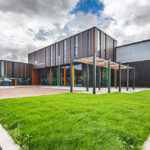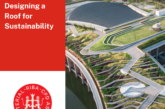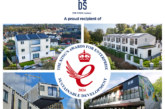Experts showcase Cambridgeshire wooden school success story with low carbon footprint and improvement of student well-being.
On Thursday 29th April, industry experts from the architecture, construction and education industry gathered to discuss how wood can successfully be used as a building material to create sustainable learning environments. Hosted by Stora Enso, in collaboration with The B1M, the webinar showcased the award-winning case study of the Northstowe Learning Community in Cambridgeshire, UK, a 15,000m2 project that utilised Cross Laminated Timber (CLT) to meet sustainability targets and provide an inspiring and healthy space for students.
The UK Government’s hardening of the carbon emissions reduction target, from 68% to 78% by 2035* puts an increasingly acute focus on how industries can support this ambition. Rory Doak, Business Development Manager UK & Ireland at Stora Enso, noted on the webinar, “the biggest impact [of the Northstowe project] is that there’s nearly 3,000 tons of CO2 stored in the building that’s not getting put back into the atmosphere”. Pair this with the reduction of up to 75% of CO2 emissions that can be achieved using wooden construction methods versus concrete and steel processes, and it’s clear to see how building with wood can contribute to this journey.
Also touching on the biophilic design nature of wood, the panellists shared insights on its positive impact on the health and well-being of children as studies have shown that the material can improve concentration and reduce stress. With return to classrooms post-pandemic in motion, this will be an incredibly important factor for educational authorities and construction players to consider.
Despite the benefits of wood as a strong, versatile, and sustainable material, the webinar also assessed the barriers to adopting CLT as a construction material. For example, concerns around technical performance exist, as does a miseducation on cost-effectiveness. Dayo ShittuBalogun, Associate at EURBAN, one important enabler of the webinar and official partner from Stora Enso, provided insight: “We’re coming across a lot of risk aversion as people still consider wood construction as a new way of doing things. There is some miseducation on cost. People consider it to be a bit more expensive, but through some benchmarking work we established that if you’re talking in simplistic terms, the structural skeleton of a building is either equal or cheaper — and more work needs to be done to communicate that this is the case.”
Sustainable school construction
When looking at the path forward for sustainable school construction in light of the Northstowe project, Dayo, added: “We all have a commitment to not pour more CO2 into the atmosphere than we take out of it, so there is a moral obligation for all of us across the industry — and where better to see this play out than in an educational setting? This is exactly what we like to do, deliver buildings efficiently and sustainably.”
Fred Mills, Co-Founder of The B1M, and webinar moderator, added, “Construction methods have the power to truly effect people’s lives. It perhaps doesn’t get more important than thinking about this in the context of where future generations are learning. Wooden school projects create amazing spaces for schooling, both from an environmental, health and well-being point of view. The task now, is to raise awareness of how concepts can be moved to an implementable reality and Northstowe is a fantastic example of this.”
You can catch up on the full discussion here: https://zoom.us/webinar/register/WN_Y82uTdShSPakEZw-iKfLQw
*compared with 1990 levels
Header image shows Northstowe School, ©Frank Shaw Associates Limited









